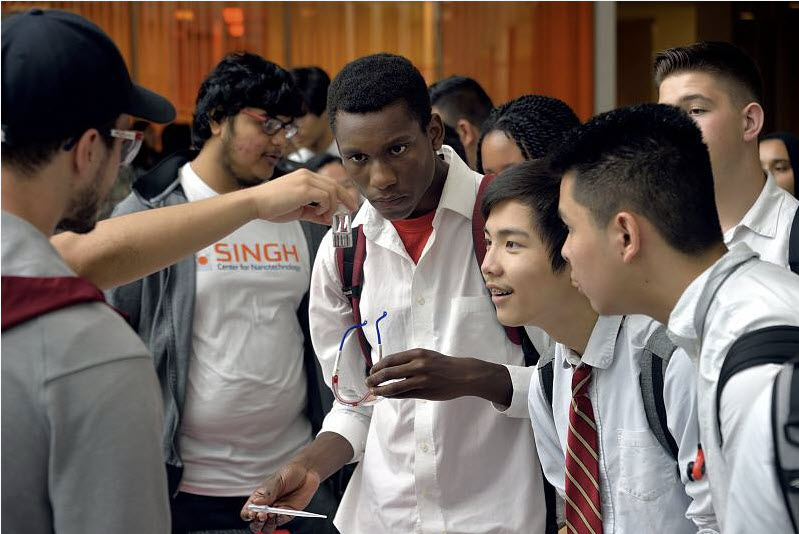NanoDay 2018
The Singh Center for Nanotechnology organized and hosted Nanoday@Penn 2018 on Tuesday October 9 by inviting 130 students from six high schools from around the region to experience hands-on demonstrations of the sciences. Participating labs were GRASP lab, AddLab, Quattrone Nanofabrication Facility (QNF), Nanoscale Characterization Facility (NCF), Scanning Probe Facility, as well as seven research labs from Engineering and from Arts and Sciences. Kyle Keenan, Laboratory Manager, Quattrone Nanofabrication Facility, commented, “The Singh Center is committed in our STEM outreach programs, and there isn’t a better way to represent our goal than by providing these high-school students with an opportunity to truly spend time in a multi-purpose nanoscience facility to interact with researchers, staff and our student volunteers, who were in their place a few years ago.”
The day began with an introduction to nanoscale concepts. The GRASP Laboratory is a rigorous inter-disciplinary robotics program for graduate and doctoral students to advance the knowledge base of robotics. It is an agile and flexible robotics research space defined by its scholarly and creative approach to robotics, science, and technology. The GRASP lab demonstrated the Cassie bipedal robot. It’s used to develop and test new two-legged locomotion strategies for walking, running.
The Penn AddLab houses the Mechanical Engineering department’s experimental and high-performance 3D printers. It primarily supports student coursework and research conducted by the Penn community. The AddLab showed how 3D printing can produce unusual and complicated parts. The students had a chance to handle these parts, from a heart-shaped set of gears to a miniature Eiffel Tower.
The Quattrone Nanofabrication Facility supports core nanofabrication capabilities and supports teaching, research, service and commercialization at the micro- and nanoscale. QNF demonstrated the fabrication and operation of microfluidic devices. Students put on safety gloves, safety glasses, and were able pour silicone molds, extract and inspect the molds, and were then able to observe a working device.
The Nanoscale Characterization Facility is a suite of rooms specifically designed to host current and next-generation scanning electron, transmission electron and atomic force microscopes. Here the students looked at a material cross-section of a dime to see that it’s mostly copper with a fairly thin nickel layer at the surfaces making it silvery. They also used a focused ion beam to mill a microscopic Lincoln Memorial in a penny.
Six research labs also participated joined in Nanoday@Penn to demonstrate aspects of their research for the students. The following labs contributed to
Murray Lab: Thin nanoscale film in everyday life, as well as metal alloys that change shape with heat but remember their original shape.
Fakhraai Lab: Lenses and light redirection.
Carpick Lab: Macroscale AFM that accurately demonstrates how an actual AFM works.
QNF Graduate Student Fellows: Fabricated quantum dots and showed how they absorb and emit light based on their geometry.
Winey and Composto Labs: Shape memory polymers.
Pikul Lab: Fabrication of energy storage materials with outstanding mechanical properties.
“When you have the support and commitment from the entire Penn community to assist in these outreach projects, which we’re grateful for, it provides for a more inclusive experience for the students, which we hope is encouraging and motivating enough to pursue careers in STEM-focused endeavors, stated Gyuseok Kim, Graduate Student Fellows Manager.
Over 150 Penn undergraduates, graduates, and postdocs signed up to volunteer for Nanoday@Penn. They served as guides for the student group, helping with preparing and serving lunch, and all the different demonstrations that made the student experience so fulfilling. Eric Johnston, Manager, Soft Lithography Facility, who spearheaded the event, stated, “Initially, it feels a massive undertaking to coordinate and arrange the scheduling, gathering volunteers, but looking at the response of the attendees and what we feel is their passion towards STEM, we understand it’s vital that we not only encourage this passion, but support it by providing them hand’s on opportunities, as we do year round in the center, it’s a minimal effort to pay. We’re the lucky ones.”






